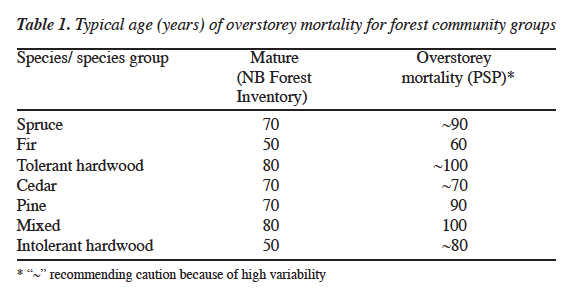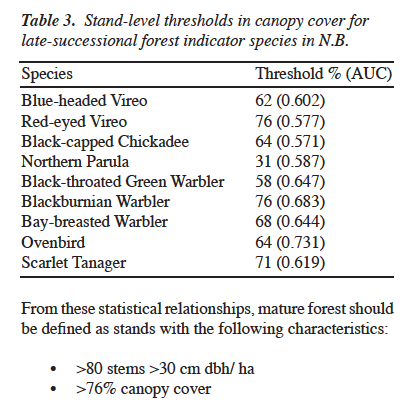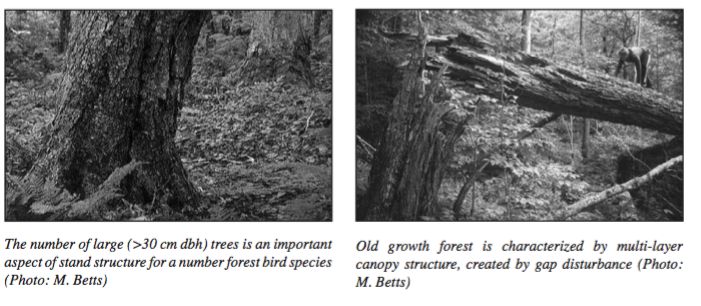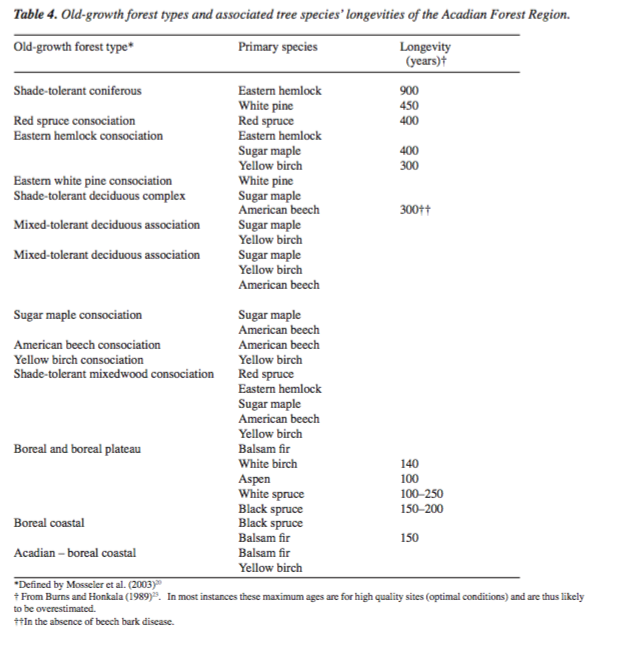FOREST MANAGEMENT GUIDELINES TO PROTECT NATIVE BIODIVERSITY IN THE GREATER FUNDY ECOSYSTEM Second Edition
Greater Fundy Ecosystem Research Group Editors: Matthew Betts and Graham Forbes, 2005. 127 pages. Comprehensive. “The goal of this document is to provide a vision for forest management based on ecological processes.” Chapter 2: Amount of Mature Forest at the Landscape Scale by MG Betts, MJ Smith, S. Woodley, and GJ Forbes is particularly pertinent to “What is Old Growth?”
From Chapter 2:
1. Introduction
Forests intensively managed for timber production generally rely on short-rotation harvest to provide maximum timber yield. This system is not conducive to the persistence of mature and old-growth stands. For example, in the Greater Fundy Ecosystem (GFE), the amount of mature forest (>60–80 years old) is declining 1–2% each year.1 This is a problem because many forest species are not found in regenerating or young stands.2,3,4,5,6 In Fennoscandian countries, where intensive silviculture has occurred for centuries, about 50% of red-listed species are threatened because of forest management.6,7 Three species of birds, 55 species of vascular plants, 202 species of invertebrates, and 199 species of lichens and fungi are listed as having forestry practices as a major cause of endangerment.7,8 Most of these species depend on structures available in mature forest, such as large trees, snags, coarse woody debris, and multiple canopy layers.8 Thus, it is important to retain mature forest in landscapes if native biodiversity is to be maintained. Recognizing this, New Brunswick Department of Natural Resources (NBDNR) has established a policy for the conservation of mature forest in NB; as part of the Habitat Objectives and Vegetation Community Objectives, licensees will be required to maintain 11–20% of mature forest on Crown land over the 80–year planning horizon.9
One of the central questions in biodiversity conservation is how much habitat to conserve.10,11 Unfortunately, this is also one of the most difficult to answer because it requires detailed, long-term information not only on habitat requirements, but also on the population dynamics of native species. In developing a guideline for the amount of late-successional forest, we have used two approaches: (1) Coarse filter: we used information on natural disturbance regimes and resulting age-class distributions of presettlement forest derived from the literature. As emphasized in the Introduction, the coarse-filter approach is based on the assumption that native species evolved under conditions existing before extensive human alteration of the North American landscape. Thus, maintaining a full range of similar conditions under forest management offers the best assurance against loss of biodiversity.12 (2) Fine filter: we developed spatially explicit population viability models for a known late-successional forest associate, the northern flying squirrel.
2. Key Biological Concepts
Defining Mature Forest
Defining which parameters constitute the components of the habitat needed by mature forest-dependent species is challenging because of the number of species involved and our limited understanding of even the most abundant ones. Therefore, we have established two bases for defining maturity: (1) the age at which stands show signs of overstorey mortality (senescence), and (2) thresholds in structural stand-level attributes that allow persistence of mature forest-indicator species.
(1) Age of Senescence
We used a broad index of maturity to provide a surrogate for the habitat requirements of many species. Maturity is defined as the onset of significant mortality of the overstorey cohort of trees. Permanent sample plot (PSP) data from New Brunswick were used to calculate the age at which tree mortality typically occurs. Not enough PSP sites exist in the GFE to use only local site data. Small sample sizes for some tree species in the PSP data limit some conclusions, so these data should be considered with some caution. The analysis of the PSP data set was conducted for seven broad community types in the GFE (see Ch. 3, Forest Community Groups). Based on these analyses, and on data from the New Brunswick Forest Inventory,13 the onset of maturity can be defined for species and the communities composed of these species (Table 1).
(2) Stand level thresholds for local indicator species
For most forest species, it is unlikely to be stand age alone that influences abundance and distribution. A wide range of structural (e.g., canopy cover, tree size) and non-structural (e.g., stand history) attributes that are correlates of stand age, may form the real bases for habitat quality. For several species associated with mature forest, habitat relationships have been examined extensively in the GFE14 and other parts of N.B..15 We used results of statistical models that related the presence of a wide range of forest bird species to vegetation structure variables.15 Of particular relevance are thresholds in the occurrence of forest species as a function of variables that are associated with mature forest and are strongly influenced by forest management: (1) canopy cover, (2) density of large (>30 cm dbh) trees/ha. Threshold values can be interpreted as the amount of vegetation variable “x” required at the stand scale to maximize the probability of correctly predicting species occurrence. Nine species were correlated with canopy cover and 11 with large trees (>30 cm dbh). Habitat requirements of these species serve as the basis for characterizing late- successional forest (Tables 2, 3).

From these statistical relationships, mature forest should be defined as stands with the following characteristics:
• >80 stems >30 cm dbh/ ha
• >76% canopy cover
Defining Old Growth
Although there is very little old-growth forest remaining in the Acadian Forest, maintaining these very old age classes is important in the conservation of genetic diversity in trees,16 and they may also serve as important habitat for a range of forest species.17,18,19 Old-growth forest types are most commonly dominated by relatively shade-tolerant, long-lived species such as sugar maple, beech, eastern hemlock, and red spruce, often with a significant component of eastern white pine and yellow birch.20 Old-growth forest is characterized by: (1) Age: average ages of about half those of the maximum longevity of the dominant tree species, with some trees at or near the maximum age12,21 (Table 4). (2) Structure and composition: multi-cohort age structure and multi-layer canopy structure, old trees, gap- or patch-replacing disturbances, snags in various stages of decay, and coarse woody debris, including some large rotting logs.12,22




